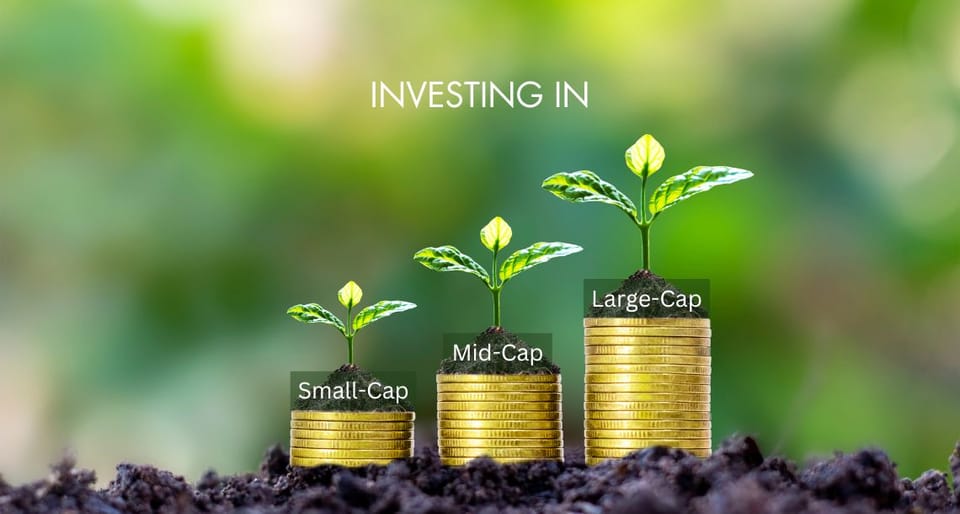Investing in Small-Cap, Mid-Cap, and Large-Cap Stocks: A Simple Guide for Your Portfolio

When you hear experienced investors talk about diversifying across different "caps," don’t let the jargon confuse you! It's simply a way of classifying companies based on their size or market value. Knowing the difference between small-cap, mid-cap, and large-cap stocks can help you build a more balanced portfolio. Let's break it down in simple terms and see how these categories have performed over the last few years.
What Are Small-Cap, Mid-Cap, and Large-Cap Stocks?
Small-Cap Stocks:
These are the smaller, growing companies in the stock market, usually with a market value of under ₹5,000 crore. They can offer high growth potential, but they are also riskier and more volatile. Think of them as "startups" in the stock market – they can grow fast, but they can also face big swings. Examples of small-cap companies might not be household names yet, but they have the potential to make a big impact.
- Risk: High volatility and higher risk.
- Performance indicator: Nifty Small Cap 100 or Small Cap 250 Index tracks these stocks.
Mid-Cap Stocks:
These companies fall in the middle – with a market value between ₹5,000 crore and ₹20,000 crore. They strike a balance between growth and stability. Mid-caps are not as risky as small-caps but can still offer strong growth potential. If you're looking for a sweet spot between safety and reward, mid-cap stocks might be right for you.
- Risk: Moderate volatility.
- Performance indicator: Mid Cap Index tracks these stocks.
Large-Cap Stocks:
Large-cap stocks are the big players in the market, with a market value above ₹20,000 crore. These are well-established companies that are leaders in their industries, like Reliance or TCS. Large-cap stocks tend to be less volatile and more stable, making them a safer choice for conservative investors.
- Risk: Low volatility, safer bet.
- Performance indicator: Nifty 50 Index tracks these stocks.
How Have These Stocks Performed Over the Last 5 Years?
Let's take a quick look at how small-cap, mid-cap, and large-cap stocks have performed recently:
- Small-Cap Stocks:
Small-cap stocks had a rough start in 2018 but came back strong in 2021 after the pandemic. They had huge gains, sometimes rising by over 50% in a year, but they can also be quite volatile. If you’re okay with ups and downs, small-cap stocks can offer big rewards. - Mid-Cap Stocks:
Mid-cap stocks performed more steadily. After a tough 2018, they rebounded well during the recovery in 2021. In 2023, mid-caps delivered solid returns, making them a good option if you want decent growth without too much risk. - Large-Cap Stocks:
Large-cap stocks were the most stable. After a dip in 2018 due to global uncertainties, they quickly recovered and have been delivering consistent returns of 15-20% annually since 2020. If you’re looking for stability, large-cap stocks are your best bet.
How to Choose the Right Mix for Your Portfolio?
Every investor has different goals and risk tolerance. Here's why you might want to mix small, mid, and large-cap stocks in your portfolio:
- Small-Cap Stocks: They can be risky, but they also have the potential for massive growth. If you can tolerate some volatility and are in it for the long haul, small-cap stocks could be worth considering.
- Mid-Cap Stocks: These stocks offer a balance of risk and reward. If you're looking for growth but don’t want to take on the full risk of small-caps, mid-caps can be a solid choice.
- Large-Cap Stocks: If you prefer stability and lower risk, large-cap stocks should make up a significant part of your portfolio. They might not grow as fast as small-cap stocks, but they offer steady returns.
Risk and Reward: What Should You Be Aware Of?
Each type of stock comes with its own risks. Here’s a breakdown:
- Small-Cap Stocks:
- Volatility: Prices can swing wildly based on market trends or news.
- Liquidity: These stocks might be harder to buy or sell quickly, as they tend to have lower trading volumes.
- Mid-Cap Stocks:
- Moderate Risk: They’re less volatile than small-caps but can still suffer during market downturns.
- Sector Risks: Many mid-cap companies are in specialized sectors, so they could be affected by changes in those industries.
- Large-Cap Stocks:
- Lower Growth: They are more stable, but you might not see the same high returns as with smaller companies.
- Macroeconomic Factors: Large-cap companies can be impacted by broad economic factors, like inflation, interest rates, or global events.
Why Diversification Matters
Diversification means spreading your investments across different types of stocks to balance risk and return. If you only invest in one type of stock (say, all large-cap or all small-cap), you’re putting all your eggs in one basket. By mixing small, mid, and large-cap stocks, you can reduce risk while still aiming for strong growth.
For example, if the market is going through a rough patch, large-cap stocks can help keep your portfolio steady. Meanwhile, if the economy is booming, small and mid-cap stocks may give your portfolio the extra boost you need.
Key Takeaways
- Small-Cap: High risk, high reward. Best for aggressive investors willing to ride out the volatility.
- Mid-Cap: Moderate risk, moderate reward. Ideal for those seeking a balance of growth and stability.
- Large-Cap: Low risk, steady growth. Perfect for conservative investors looking for stability.
Diversifying across these categories will help you build a portfolio that works for you—whether you're aiming for growth or seeking to protect your investments in uncertain times.
Before making any investment decisions, it’s always a good idea to consult with a financial advisor to create a plan that fits your financial goals, risk tolerance, and time horizon.
At Fynocrat, we believe in smart investing. Understanding small-cap, mid-cap, and large-cap stocks can give you the knowledge to make better investment choices and build a more resilient portfolio.






Member discussion